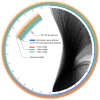Insights into an Extensively Fragmented Eukaryotic Genome: De Novo Genome Sequencing of the Multinuclear Ciliate Uroleptopsis citrina
- PMID: 29608728
- PMCID: PMC5863220
- DOI: 10.1093/gbe/evy055
Insights into an Extensively Fragmented Eukaryotic Genome: De Novo Genome Sequencing of the Multinuclear Ciliate Uroleptopsis citrina
Abstract
Ciliated protists are a large group of single-celled eukaryotes with separate germline and somatic nuclei in each cell. The somatic genome is developed from the zygotic nucleus through a series of chromosomal rearrangements, including fragmentation, DNA elimination, de novo telomere addition, and DNA amplification. This unique feature makes them perfect models for research in genome biology and evolution. However, genomic research of ciliates has been limited to a few species, owing to problems with DNA contamination and obstacles in cultivation. Here, we introduce a method combining telomere-primer PCR amplification and high-throughput sequencing, which can reduce DNA contamination and obtain genomic data efficiently. Based on this method, we report a draft somatic genome of a multimacronuclear ciliate, Uroleptopsis citrina. 1) The telomeric sequence in U. citrina is confirmed to be C4A4C4A4C4 by directly blunt-end cloning. 2) Genomic analysis of the resulting chromosomes shows a "one-gene one-chromosome" pattern, with a small number of multiple-gene chromosomes. 3) Amino acid usage is analyzed, and reassignment of stop codons is confirmed. 4) Chromosomal analysis shows an obvious asymmetrical GC skew and high bias between A and T in the subtelomeric regions of the sense-strand, with the detection of an 11-bp high AT motif region in the 3' subtelomeric region. 5) The subtelomeric sequence also has an obvious 40 nt strand oscillation of nucleotide ratio. 6) In the 5' subtelomeric region of the coding strand, the distribution of potential TATA-box regions is illustrated, which accumulate between 30 and 50 nt. This work provides a valuable reference for genomic research and furthers our understanding of the dynamic nature of unicellular eukaryotic genomes.
Figures








Similar articles
-
Exploration of the Germline Genome of the Ciliate Chilodonella uncinata through Single-Cell Omics (Transcriptomics and Genomics).mBio. 2018 Jan 9;9(1):e01836-17. doi: 10.1128/mBio.01836-17. mBio. 2018. PMID: 29317511 Free PMC article.
-
Chromosome organization and gene expansion in the highly fragmented genome of the ciliate Strombidium stylifer.J Genet Genomics. 2021 Oct 20;48(10):908-916. doi: 10.1016/j.jgg.2021.05.014. Epub 2021 Jul 3. J Genet Genomics. 2021. PMID: 34452852
-
Variation in macronuclear genome content of three ciliates with extensive chromosomal fragmentation: a preliminary analysis.J Eukaryot Microbiol. 2007 May-Jun;54(3):242-6. doi: 10.1111/j.1550-7408.2007.00257.x. J Eukaryot Microbiol. 2007. PMID: 17552979
-
Programmed genome rearrangements in ciliates.Cell Mol Life Sci. 2020 Nov;77(22):4615-4629. doi: 10.1007/s00018-020-03555-2. Epub 2020 May 27. Cell Mol Life Sci. 2020. PMID: 32462406 Free PMC article. Review.
-
Genome remodeling in ciliated protozoa.Annu Rev Microbiol. 2002;56:489-520. doi: 10.1146/annurev.micro.56.012302.160916. Epub 2002 Jan 30. Annu Rev Microbiol. 2002. PMID: 12142486 Review.
Cited by
-
Conjugation in Euplotes raikovi (Protista, Ciliophora): New Insights into Nuclear Events and Macronuclear Development from Micronucleate and Amicronucleate Cells.Microorganisms. 2020 Jan 23;8(2):162. doi: 10.3390/microorganisms8020162. Microorganisms. 2020. PMID: 31979289 Free PMC article.
-
Characterization of Simple Sequence Repeats (SSRs) in Ciliated Protists Inferred by Comparative Genomics.Microorganisms. 2020 May 1;8(5):662. doi: 10.3390/microorganisms8050662. Microorganisms. 2020. PMID: 32370063 Free PMC article.
-
From germline genome to highly fragmented somatic genome: genome-wide DNA rearrangement during the sexual process in ciliated protists.Mar Life Sci Technol. 2024 Feb 12;6(1):31-49. doi: 10.1007/s42995-023-00213-x. eCollection 2024 Feb. Mar Life Sci Technol. 2024. PMID: 38433968 Free PMC article.
-
Decryption of the survival "black box": gene family expansion promotes the encystment in ciliated protists.BMC Genomics. 2024 Mar 18;25(1):286. doi: 10.1186/s12864-024-10207-3. BMC Genomics. 2024. PMID: 38500030 Free PMC article.
-
Nontriplet feature of genetic code in Euplotes ciliates is a result of neutral evolution.Proc Natl Acad Sci U S A. 2023 May 30;120(22):e2221683120. doi: 10.1073/pnas.2221683120. Epub 2023 May 22. Proc Natl Acad Sci U S A. 2023. PMID: 37216548 Free PMC article.
References
-
- Baek Y-S, Jung J-H, Min G-S.. 2011. Redescription of two marine ciliates (Ciliophora: Urostylida: Pseudokeronopsidae), Pseudokeronopsis carnea and Uroleptopsis citrina, from Korea. Korean J Syst Zool. 27:220–227.
Publication types
MeSH terms
Substances
LinkOut - more resources
Full Text Sources
Other Literature Sources
Research Materials
Miscellaneous

